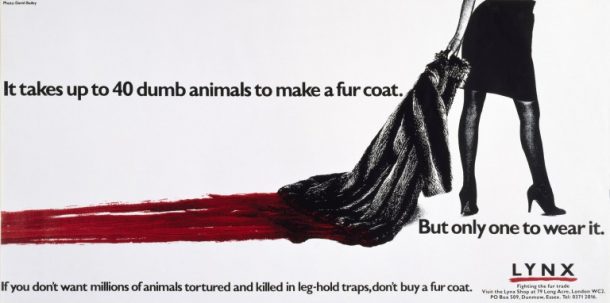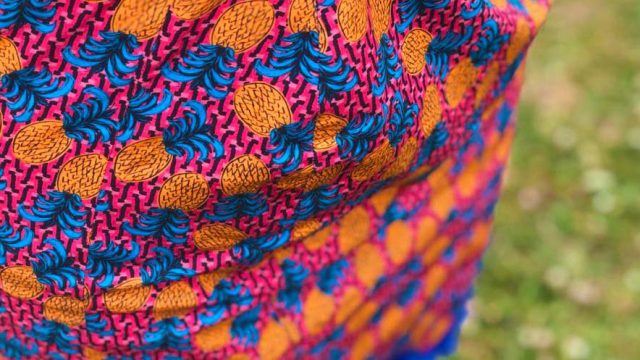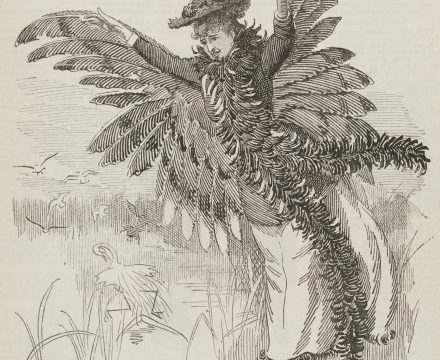Protest against the environmental impact and impact on species of the fashion industry is a recurring theme in Fashioned from Nature. Groups such as Lynx were key to changing the industry.

In collaboration with art director Jeremy Pemberton, fashion photographer David Bailey shot this striking poster in 1984, featuring the lower body of a woman in short black skirt, tights and high-heeled shoes, dragging behind her a fur coat that has left a trail of bright red blood in its wake. The attention-grabbing slogan by copywriter Alan Page directly accuses fur-wearers, going beyond the usual narrative of the pain inflicted on animals. The work was commissioned in protest against the fur trade by anti-fur organisation Lynx in 1984 and was part of a campaign for Greenpeace. A TV commercial of the same theme with music by Vangelis was produced in the following year, which was even more arresting than the poster. It showed models in fur coats striking poses down the catwalk while splashing blood onto their audience, similarly leaving a broad trail of blood on the runway.
Lynx co-founder, Lynne Kentish, who wished to professionalise the animal rights movement recalls: ‘it was all a bit shabby up to then. No one was putting professional-looking campaign stuff out.’ Mark Glover, also a co-founder of Lynx, believed that the campaign had a phenomenal impact as one of the very first to adopt a consumer-facing strategy. The reach of the fur trade was much greater than it is today. Glover made the case by explaining that every Debenhams store had a fur department and many towns and cities had fur shops in the ‘80s; it was the ‘Dumb Animals’ campaign that persuaded people to change their perception of fur from something glamourous to something grotesque and immoral.
The hard-hitting visuals of both the poster and video are impossible to ignore. Riding the wave of the high publicity of the ‘Dumb Animals’ campaign, Linda McCartney subsequently shot the ‘Rich Bitch, Poor Bitch’ poster for Lynx in 1989 (V&A: E.3038-1991). In spite of their success in raising awareness, the sexist undertone of these campaigns generated controversy.
Such controversy paved the way for a media commotion: anti-fur and pro-fur groups defended their beliefs while publicly condemning each other. More than a decade after the campaign was launched, it continued to be referenced in popular media by both groups. A health article in the Independent in 1998 titled ‘Get warm for winter and don’t be a dumb animal’ argues that fur coats are lifesavers that could potentially save 40,000 more people from winter mortality in Britain. Meanwhile, more and more organisations such as PETA, ARME, BBC Earth, National Geographics and other independent filmmakers have produced a succession of documentaries exposing the brutal reality of the fur industry, calling for an end to the fur trade.

Nonetheless, there was a 70% increase in fur sales from 2000 to 2010, over $14 billion worldwide, and the UK alone had a 40% increase in just one year (2010). Fur companies like the Copenhagen-based Saga Furs, which alone held more than 65% of the global market share in mink and fox in the 2000s, have continuously sponsored fashion students and small fashion houses from the UK, Sweden, France and Italy, to China, Japan and Korea. In doing so, they entice and train emerging fashion talents to develop a career skewed towards using fur in their collections. Pro-fur organisations like the British Fur Trade Association (BFTA), the International Fur Trade Federation (IFTF), and America’s Fur Commission (AFC) have proceeded to defend fur as the more environmentally-friendly option in comparison with faux fur, which has been on the rise in both luxury and high street fashion in recent years. Faux fur is usually made from non-renewable and non-biodegradable materials such as coal, petroleum and limestone. The extraction, fraction and conversion of these materials during the manufacturing process are energy intensive and release harmful chemicals into the water, risking both flora and fauna.
More than three decades after the industry-shaking ‘Dumb Animals’ campaign, the fight against fur proves to be an ongoing, yet hopeful one. Less than two months after the opening of Fashioned from Nature, Westminster has started debates on banning fur imports to the UK, sparking a new wave of anti-fur protest. Earlier this year, luxury designer brands including Versace, Gucci, Burberry, and Mulberry announced they would be going fur free. If the making and wearing of fur can no longer be justified in today’s world and faux fur is simultaneously being criticised for its harm, perhaps, we can count on emerging designers to develop more sustainable alternatives, like the ones shown in Fashioned from Nature.
With the closing date of Fashioned from Nature approaching, the next post will look at the favourite inspired-by-nature garments of staff from across the museum.
This post was edited on 20 September 2021 to acknowledge the contribution of Alan Page (writer) and Jeremy Pemberton (Art Director/Creative Director).




In the 1980s I worked for the advertising agency that did the ‘dumb animals’ poster and commercial. Credit should also go to the creators of the campaign – Alan Page (writer) and Jeremy Pemberton (art director/creative director). The memorable campaign went on (deservedly) to win many awards.
Dear Bill,
I worked as a Research Assistant on Fashioned from Nature and would like to apologise for this oversight on behalf of the team. As you say, Alan Page and Jeremy Pemberton should be acknowledged so we’ve edited the blog post to include them. They are correctly acknowledged in the object record and are listed as the artists/makers on the Explore the Collections record so this should be avoided in the future.
Please do accept our apologies.
Best wishes,
Yona